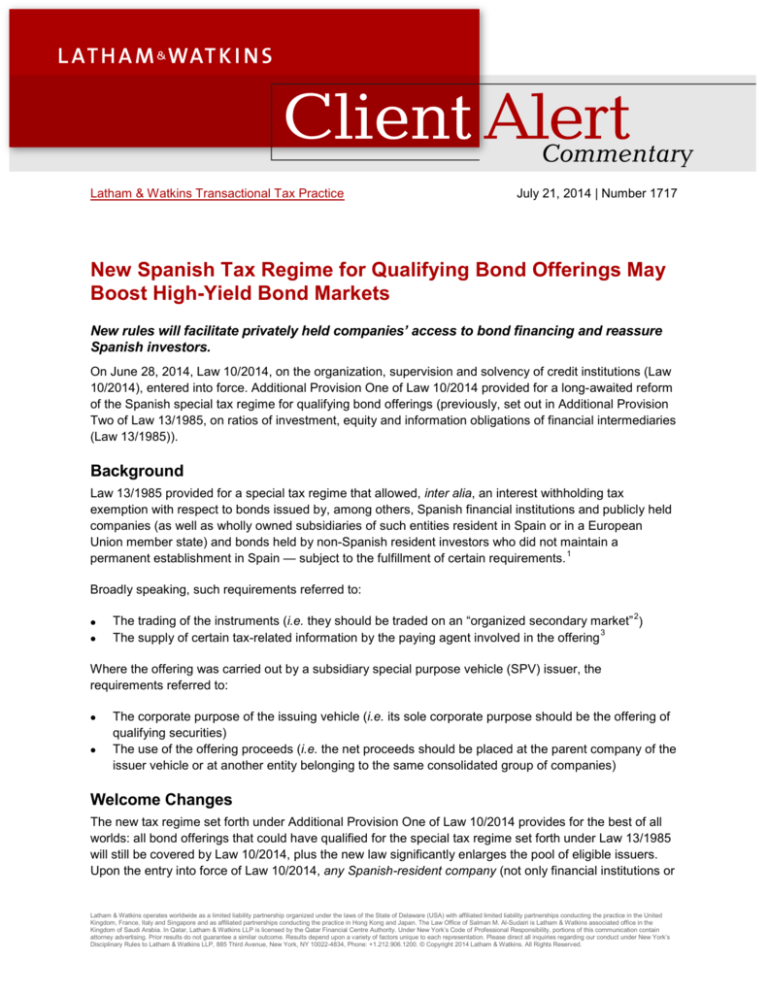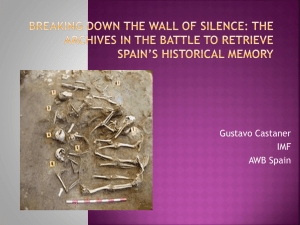
Latham & Watkins Transactional Tax Practice
July 21, 2014 | Number 1717
New Spanish Tax Regime for Qualifying Bond Offerings May
Boost High-Yield Bond Markets
New rules will facilitate privately held companies’ access to bond financing and reassure
Spanish investors.
On June 28, 2014, Law 10/2014, on the organization, supervision and solvency of credit institutions (Law
10/2014), entered into force. Additional Provision One of Law 10/2014 provided for a long-awaited reform
of the Spanish special tax regime for qualifying bond offerings (previously, set out in Additional Provision
Two of Law 13/1985, on ratios of investment, equity and information obligations of financial intermediaries
(Law 13/1985)).
Background
Law 13/1985 provided for a special tax regime that allowed, inter alia, an interest withholding tax
exemption with respect to bonds issued by, among others, Spanish financial institutions and publicly held
companies (as well as wholly owned subsidiaries of such entities resident in Spain or in a European
Union member state) and bonds held by non-Spanish resident investors who did not maintain a
1
permanent establishment in Spain — subject to the fulfillment of certain requirements.
Broadly speaking, such requirements referred to:
•
•
2
The trading of the instruments (i.e. they should be traded on an “organized secondary market” )
3
The supply of certain tax-related information by the paying agent involved in the offering
Where the offering was carried out by a subsidiary special purpose vehicle (SPV) issuer, the
requirements referred to:
•
•
The corporate purpose of the issuing vehicle (i.e. its sole corporate purpose should be the offering of
qualifying securities)
The use of the offering proceeds (i.e. the net proceeds should be placed at the parent company of the
issuer vehicle or at another entity belonging to the same consolidated group of companies)
Welcome Changes
The new tax regime set forth under Additional Provision One of Law 10/2014 provides for the best of all
worlds: all bond offerings that could have qualified for the special tax regime set forth under Law 13/1985
will still be covered by Law 10/2014, plus the new law significantly enlarges the pool of eligible issuers.
Upon the entry into force of Law 10/2014, any Spanish-resident company (not only financial institutions or
Latham & Watkins operates worldwide as a limited liability partnership organized under the laws of the State of Delaware (USA) with affiliated limited liability partnerships conducting the practice in the United
Kingdom, France, Italy and Singapore and as affiliated partnerships conducting the practice in Hong Kong and Japan. The Law Office of Salman M. Al-Sudairi is Latham & Watkins associated office in the
Kingdom of Saudi Arabia. In Qatar, Latham & Watkins LLP is licensed by the Qatar Financial Centre Authority. Under New York’s Code of Professional Responsibility, portions of this communication contain
attorney advertising. Prior results do not guarantee a similar outcome. Results depend upon a variety of factors unique to each representation. Please direct all inquiries regarding our conduct under New York’s
Disciplinary Rules to Latham & Watkins LLP, 885 Third Avenue, New York, NY 10022-4834, Phone: +1.212.906.1200. © Copyright 2014 Latham & Watkins. All Rights Reserved.
publicly held entities, or wholly owned subsidiary SPVs of such entities) will be able to benefit from the
special regime.
In addition, offerings carried out by (i) wholly owned subsidiary SPVs of such Spanish-resident companies
that are resident within the European Union, and (ii) public entities in corporate form (entidades públicas
empresariales), will also benefit from such regime.
This is a welcome development in Spanish tax law, since privately held companies had no access to the
previous regime set forth under Law 13/1985 and had to deal with a complex (and challenging) tax
environment in order to obtain financing in the bond market. After the enactment of the new law, the
structuring of such bond offerings will be greatly simplified.
Clarity About the “Organized Secondary Market”
Furthermore, the new tax regime of Law 10/2014 has introduced certain technical improvements with
respect to the old regime: one of the big question marks regarding the applicability of the regime set forth
under Law 13/1985 referred to the trading venue of the bonds. As noted above, Law 13/1985 required
bonds to be traded on an “organized secondary market,” but provided no certainty as to whether such
term of art could be deemed to refer both to “regulated exchanges” and “multilateral trading facilities”
4
(within the meaning of the MiFID Directive ).
From a market perspective, multilateral trading facilities (such as the Luxembourg Euro MTF and the Irish
Global Exchange Market (GEM)) were extremely popular among European issuers. While market
participants were relatively comfortable with their use, Spanish issuers generally alerted investors with a
“risk factor,” included in the offering documentation, about the risk that the Spanish Tax Authorities took
the view that the requirement set forth under Law 13/1985 required the bonds to be traded on a regulated
exchange. While a tax ruling issued by the Spanish Tax Authorities in late 2013 seemed to sanction the
5
use of multilateral trading facilities, the ruling still did not provide full certainty in that regard.
The new tax regime addresses this issue and casts doubts away. Under Law 10/2014, the listing
requirement now refers to “regulated exchanges, multilateral trading systems and other organized
exchanges.”
The chart below highlights the main differences between the new tax regime under Law 10/2014 and the
previous one with regard to bond offerings:
Main eligible issuers
Latham & Watkins
Old regime (Additional
Provision Two of Law 13/1985)
New regime (Additional
Provision One of Law 10/2014)
Spanish financial institution or
publicly traded entity, or wholly
owned subsidiary of such
persons resident in Spain or in
6
the EU.
There is no longer a reference to
“financial institutions” or “publicly
traded entities,” since any offering
carried out by a Spanish-resident
entity (publicly held or not) or its
wholly owned subsidiaries
resident in Spain or in the EU may
qualify. Public entities in corporate
form are expressly included within
the scope of the special regime.
July 21, 2014 | Number 1717 | Page 2
Requirements as to issuer
vehicle
If the issuer vehicle was a wholly
owned SPV, its corporate
purpose should be limited to the
issuance of securities.
No longer applicable.
Requirements as to notes
Listing of the notes on an
“organized secondary market.”
Listing of the notes on a regulated
exchange, multilateral trading
facility or any organized
exchange.
The bonds must not grant voting
rights or preferred subscription
rights with respect to future bond
offerings.
Requirements as to offering
proceeds (in case the
offering is carried out by a
subsidiary SPV issuer)
The net proceeds should be
placed within an entity belonging
to the same consolidated group
or subgroup of companies.
Similar to old regime.
Tax certification procedures
Payment statement to be
supplied by the paying agent
(contents will depend on the
clearing systems involved).
Similar to old regime.
Remaining Ambiguities
Market participants should note that even though the regime enacted by Law 10/2004 is great news for
Spanish enterprises, the new tax regime still does not fully address certain relevant aspects. On the one
hand, Law 10/2004 does not provide for a “grandfathering” provision, meaning that bond offerings
launched before its entry into force (on June 28, 2014) are not able to benefit from its provisions. The new
law may also fail to dispell doubts as to whether a “tap” offering could benefit from the new tax regime
too. In addition, Spanish issuers may need to iron out structuring issues if they intend to carry out an
offering through a subsidiary SPV issuer resident for tax purposes in Spain. If such an issuer vehicle onlends the offering proceeds to a Spanish-resident parent company, there may be withholding tax
leakages with respect to such a proceeds loan if both entities do not belong to the same fiscal unity for
Spanish tax purposes.
Conclusion
Notwithstanding the above, the developments introduced by Law 10/2014 are in line with the Spanish
Government’s intention to allow Spanish enterprises to access the international bond markets and may
facilitate their access to bond financing (and, in particular, to the high-yield bond market).
Latham & Watkins
July 21, 2014 | Number 1717 | Page 3
If you have questions about this Client Alert, please contact one of the authors listed below or the Latham
lawyer with whom you normally consult:
Ignacio Pallarés
ignacio.pallares@lw.com
+34.93.545.5019 | Barcelona
+34.91.791.5019 | Madrid
Iván Rabanillo
ivan.rabanillo@lw.com
+34.91.791.50.36
Madrid
You Might Also Be Interested In
Tax Ruling Offers Welcome Clarification on Spanish Regime for Qualifying Bond Offerings
Client Alert is published by Latham & Watkins as a news reporting service to clients and other friends.
The information contained in this publication should not be construed as legal advice. Should further
analysis or explanation of the subject matter be required, please contact the lawyer with whom you
normally consult. The invitation to contact is not a solicitation for legal work under the laws of any
jurisdiction in which Latham lawyers are not authorized to practice. A complete list of Latham’s Client
Alerts can be found at www.lw.com. If you wish to update your contact details or customize the
information you receive from Latham & Watkins, visit http://events.lw.com/reaction/subscriptionpage.html
to subscribe to the firm’s global client mailings program.
Endnotes
1
Such special tax regime also applies with respect to qualifying offerings of preferred shares. This Client Alert references only the
aspects relevant for bond offerings, and does not address the particular requirements applicable to offerings of preferred shares.
2
This is a term of art that was not defined under Spanish law, and which has given rise to controversies in the past, as explained
in our Client Alert dated February 12, 2014 (“Tax Ruling Offers Welcome Clarification on Spanish Regime for Qualifying Bond
Offerings”), available at www.lw.com/thoughtLeadership/lw-spain-tax-ruling-bonds.
3
Under the applicable Spanish regulations (article 44 of Royal Decree 1065/2007, dated July 27, 2007), the applicability of the
withholding tax exemption requires that the paying agent involved in the offering supplies the issuer, prior to the interest
payment date, with a payment statement providing for certain information relating to the payment that is relevant for Spanish tax
purposes. Where the bonds are registered at a clearing system operated by a regulated clearing entity not based in Spain (such
as e.g. Euroclear or Clearstream), then the payment statement to be supplied by the paying agent involved should include
details on the identification of the bonds, the payment date, the amount of income to be paid on the relevant payment date, and
the total amount of income corresponding to Notes held through such non-Spanish clearing systems.
4
Markets in Financial Instruments Directive (Directive 2004/39/EC).
5
The contents of such tax ruling are explained in detail in our Client Alert dated February 12, 2014 (“Tax Ruling Offers Welcome
Clarification on Spanish Regime for Qualifying Bond Offerings”), available at www.lw.com/thoughtLeadership/lw-spain-taxruling-bonds.
6
Offerings carried out by Spanish issuer SPVs of a non-Spanish financial institution or publicly traded company could also qualify
for this regime.
Latham & Watkins
July 21, 2014 | Number 1717 | Page 4









